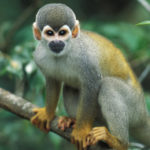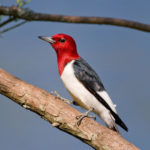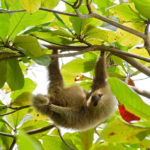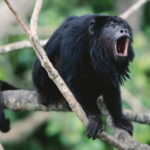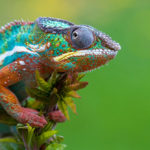Lemurs – information
 Small types of lemurs are typically wood animals, they move along branches of trees and do not descend to the ground. Usually lemurs walk on branches on four limbs, and also make short jumps, hugging trunks with tenacious palms and feet. The long tail of lemurs serves as a balance for jumping and has no grasping functions, as is often observed in monkeys. Large lemurs also live on trees, but on the ground they move more willingly, making long detours of the territory.
Small types of lemurs are typically wood animals, they move along branches of trees and do not descend to the ground. Usually lemurs walk on branches on four limbs, and also make short jumps, hugging trunks with tenacious palms and feet. The long tail of lemurs serves as a balance for jumping and has no grasping functions, as is often observed in monkeys. Large lemurs also live on trees, but on the ground they move more willingly, making long detours of the territory.
Daytime species of lemurs like to sunbathe, dying in the sun with their legs lifted, or stretched out on branches. Lemurs sleep either sitting, head down between their paws (large species), or curled up in a ball (small species). The latter even arrange nests for overnight lodging or use hollows.
All kinds of lemurs are herbivorous, they feed on kidneys, young shoots and leaves of trees, flowers, fruits (bananas, figs), sometimes bark. At the same time, these animals are not averse to diversifying their diet with insects, honey and even bird eggs.
The breeding season is somehow timed to the rainy season. There are no special mating rituals for these animals, pregnancy lasts for different species from 2 to 5 months. Lemurs often spawn 2-3 cubs, while many monkeys bring only one. The young are small (in a dwarf lemur weigh 3-5 grams, in a cat’s 80 g), first they cling to the mother’s fur on their stomachs, and then move on to her back. The female feeds the baby with milk from several weeks to a couple of months, but the lemurs become independent sooner. Small dwarf lemur becomes independent at 2 months, and a large feline – at 6. The maturity of these species occurs respectively at 10 and 18 months, and live lemurs up to 20-27 years.
In Madagascar there are no ordinary African predators, therefore the main enemies of lemurs are hawks and one more endemic island – Fossa. Fossa resembles a giant marten, it deftly runs around the branches and is very dangerous for lemurs.
All kinds of lemurs are in a threatening position and listed in the Red Book, especially poorly studied small night species, the number of which is difficult to calculate. The main danger for lemurs lies in the destruction of natural habitats, since relict forests are being cut down in Madagascar, and in other places these animals can not live. At the same time, lemurs are well established in captivity, where many large species successfully reproduce. Thus, the cat’s lemur has become one of the most common inhabitants of zoos.








